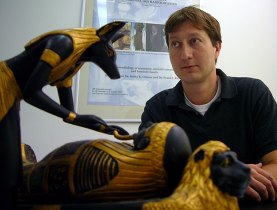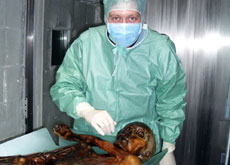Swiss research unlocks mummy secrets

A leading Swiss anatomy expert has managed to mummify a body part using the same salt drying process the ancient Egyptians employed.
Frank Rühli, who has also examined the King Tutankhamun CT (computed tomography) scans and the Ötzi iceman mummy, is looking at how human tissue reacts during mummification, in what is a unique project.
Rühli’s laboratory is set in the depths of Zurich University’s Irchel campus. In one corner stands a wooden box, filled with salt, behind a protective screen. Just visible in the box is an outline of a shape.
The researcher has used a salt mixture based on a mid-1990s United States study, which tried to determine the “magic formula” used by ancient Egyptians to dry out bodies before burial.
“It’s amazing how much you actually need, so far we have used around 60 kilograms,” said Rühli, who leads the research at the university’s Institute of Anatomy, as part of the internationally acclaimed Swiss Mummy Project.
“In the 1990s study more than 200kg of salt was needed for the mummification process of a whole body,” Rühli told swissinfo.ch.
Rühli’s experiment, which has been running for almost 80 days, is the first of its kind worldwide using the most up-to-date methods – radiological technology, magnetic resonance imaging (MRI) and computer tomography at the Orthopaedic University Hospital in Zurich.
At the Institute of Anatomy, tissue and DNA are also studied, the latter to see how much it degrades during mummification.
Surprising result
Surprisingly, mummification has taken longer than the 70 days expected, said Rühli.
“We did some analysis a few days ago and we still see on the magnetic resonance image that there are signals for water. This means that there is still some sort of humidity in the tissue which we had expected to have decreased further.”
Rühli said that although much is known about ancient Egyptian mummification – believed by them to be essential for passage to the afterlife – it is not fully clear how much time was invested in the salt part.
The body was dried out with salts after the inner organs had been removed. The skin was then treated with oils and resins. After this, the body was wrapped in linens, covered in protective amulets and placed in a coffin.
The rich and the Pharaohs had the most spectacular tombs, while the poor were generally buried in the desert where the hot sand produced a natural mummification process.
The Zurich experiment certainly looks like a museum mummy. “If you take the salt off, from a morphological and macroscopic point of view, it has the appearance of dry tissue, looking dark greenish brownish,” Rühli said.
A whole body?
The researcher expects to continue his experiment for another month. Towards the end of the year he will embark on a second round of body part mummification to see if it produces the same results. He will look at the heat mummification process as well.
Eventually Rühli would like to do a whole body mummification using the salt process, but this would be a huge logistical undertaking. He is using a leg for his present study.
All body parts used are donated, said Rühli. “These kinds of body parts are donated to research during the life time of the deceased people and the whole project underwent screening and approval by the local ethics committee,” he said.
The idea of the research, which is funded by the Swiss National Science Foundation, is to see how human tissue reacts under various environmental conditions, such as change of temperature and humidity.
The results could also be of use to modern forensics, which is sometimes confronted with old and newly mummified bodies.
Mummy fascination
Rühli himself has worked on two of the most famous mummies of all, including Tutankhamun.
The pharaoh’s body underwent a CT scan in Cairo in 2005. It allowed Rühli to establish that the boy king did not die from a blow to the head as previously thought. The exact cause of death is still unknown.
Rühli was also able to show that “Ötzi”, the glacier mummy from 3,300 BC found in the Austrian-Italian Alps, died from blood loss from an arrow wound. This kind of chance mummification would also be interesting to recreate, said Rühli, but would need extra funding.
The researcher says that the public’s fascination with mummies comes from the fact that people are confronted with an almost lifelike person who may have been dead for thousands of years.
As for the medical doctor, his research reunites two interests. “I’m medically interested in how tissue reacts, but I’m historically interested to know how ancient cultures tried to preserve their loved ones after death,” he said.
For the lifelong fan of mummies, “this combination is quite unique”.
Isobel Leybold-Johnson in Zurich, swissinfo.ch
The aim of this project, chaired by Rühli, is the minimal and non-invasive examination of human mummies mostly from Swiss collections. But his expertise is also in demand internationally as with King Tutankhamun and Ötzi iceman examples.
The methods used include X-rays, endoscopy, CT scans, MRI, light and electron microscopy as well as “meta-analysis” of literature on mummies.
Besides individual anatomical variants and pathologies, changes before and after death are investigated.
Skin and dried flesh have been preserved by exposure to chemicals, extreme cold, very low humidity, or by lack of air when submerged.
The best-known mummies are those that were embalmed for preservation, particularly those in ancient Egypt. This concerned not just humans but also crocodiles and cats.
In China, preserved corpses have been recovered from wooden coffins found underwater and packed with medicinal herbs.
Although Egyptian mummies are the most famous, the oldest found are the Chinchorro mummies (up to 7,000 years old) from northern Chile and southern Peru.

In compliance with the JTI standards
More: SWI swissinfo.ch certified by the Journalism Trust Initiative












You can find an overview of ongoing debates with our journalists here . Please join us!
If you want to start a conversation about a topic raised in this article or want to report factual errors, email us at english@swissinfo.ch.